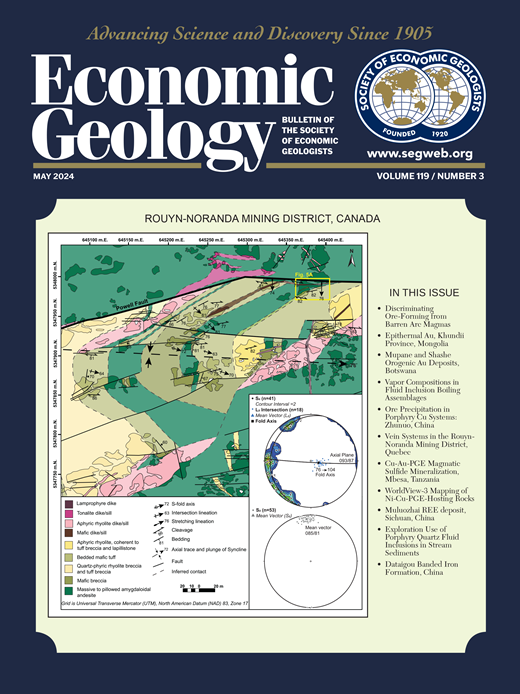Are Placer Platinum Nuggets Formed During Lateritization? The Verdict from the Owendale Alaskan-Uralian Complex in Australia Is an Emphatic No!
IF 4.9
1区 地球科学
Q1 GEOCHEMISTRY & GEOPHYSICS
引用次数: 0
Abstract
Abstract The thick laterite developed over platinum group element (PGE)-bearing ultramafic rocks of the Owendale Alaskan-Uralian Complex in New South Wales, Australia, provides an ideal environment in which to address the question of whether Pt-Fe nuggets are formed during lateritization. This is an important issue to settle because Pt-Fe nuggets in alluvial placers and eluvial deposits associated with the Alaskan-Uralian complexes were the world’s major source of Pt prior to the commencement of Pt production from the Bushveld Complex and continue to produce a significant amount of Pt. Some of the Owendale laterites have high Pt but low Cu contents, while others have both high Pt and high Cu contents. Heavy mineral concentrates were prepared from about 1 kg of drill chips from both types of laterites. Only five of the 61 samples processed contained any platinum group minerals (PGMs) greater than 5 μm in size, even though many of the samples contained more than 1 g/t Pt. The largest PGM found was about 100 μm long, and the majority were <20 μm. The bulk of the PGMs recovered were zoned PGMs consisting of a core of isoferroplatinum mantled by tetraferroplatinum with an outer rim of tulameenite; many of these zoned PGMs are encased in hematite grains that often have high Pt contents and appear to be pseudomorphs after the PGMs. The textural evidence indicates that at least half of the primary PGMs in the ultramafic protoliths to the laterites were destroyed during weathering and that the liberated PGEs could have been available for the formation of PGM nuggets. However, despite the large amount of PGEs liberated during the destruction of the primary PGMs, no evidence was found for the neogenic growth of PGE nuggets. Rather, the Pt liberated during the destruction of the PGMs appears to have only traveled distances of micrometers to tens of centimeters to form Pt nanoparticles or Pt oxides or to be absorbed/adsorbed by the Fe oxide hosts.砂矿铂金块是否在红土化过程中形成?来自澳大利亚欧文代尔阿拉斯加-乌拉尔综合体的结论是一个断然的否定!
在澳大利亚新南威尔士州的Owendale alaska - uralian杂岩中,厚红土发育在含铂族元素(PGE)的超基性岩石上,为研究Pt-Fe块体是否在红土化过程中形成提供了理想的环境。这是一个需要解决的重要问题,因为在Bushveld复矿开始生产Pt之前,阿拉斯加-乌拉利亚复矿相关的冲积砂矿和淋积矿床中的Pt- fe块体是世界上主要的Pt来源,并继续生产大量的Pt。Owendale红土中的一些Pt含量高,但Cu含量低,而另一些则既有高Pt含量,也有高Cu含量。从这两种红土中提取约1公斤的钻屑制备了重矿物精矿。在处理的61个样品中,只有5个样品含有大于5 μm的铂族矿物(PGMs),尽管许多样品含有超过1 g/t的铂。发现的最大的铂族矿物长约100 μm,大多数为20 μm。大部分回收的铂族金属为带状铂族金属,由四铁铂包裹的异铁铂核和图拉铁矿外缘组成;许多分带的铂族金属包裹在富含Pt的赤铁矿颗粒中,在铂族金属之后呈假晶状。结构证据表明,红土超镁质原岩中至少有一半的原生PGM在风化过程中被破坏,释放出来的PGM可能用于形成PGM块。然而,尽管在原始pgm的破坏过程中释放了大量的PGE,但没有发现PGE块体新生生长的证据。相反,在pgm破坏过程中释放的Pt似乎只移动了几微米到几十厘米的距离,以形成Pt纳米颗粒或Pt氧化物或被Fe氧化物宿主吸收/吸附。
本文章由计算机程序翻译,如有差异,请以英文原文为准。
求助全文
约1分钟内获得全文
求助全文
来源期刊

Economic Geology
地学-地球化学与地球物理
CiteScore
10.00
自引率
6.90%
发文量
120
审稿时长
6 months
期刊介绍:
The journal, now published semi-quarterly, was first published in 1905 by the Economic Geology Publishing Company (PUBCO), a not-for-profit company established for the purpose of publishing a periodical devoted to economic geology. On the founding of SEG in 1920, a cooperative arrangement between PUBCO and SEG made the journal the official organ of the Society, and PUBCO agreed to carry the Society''s name on the front cover under the heading "Bulletin of the Society of Economic Geologists". PUBCO and SEG continued to operate as cooperating but separate entities until 2001, when the Board of Directors of PUBCO and the Council of SEG, by unanimous consent, approved a formal agreement of merger. The former activities of the PUBCO Board of Directors are now carried out by a Publications Board, a new self-governing unit within SEG.
 求助内容:
求助内容: 应助结果提醒方式:
应助结果提醒方式:


